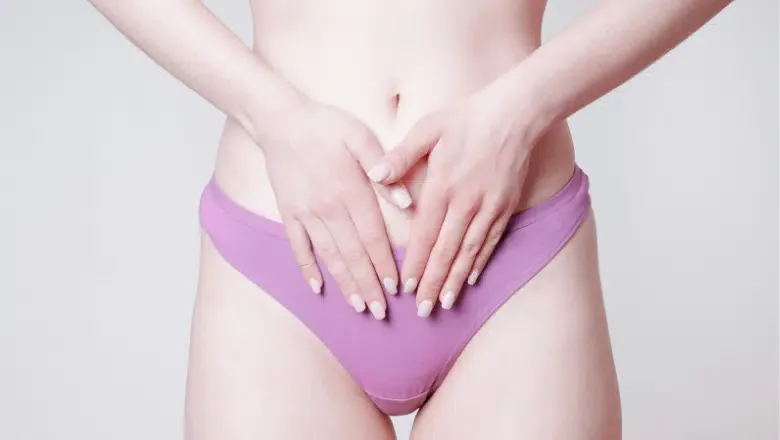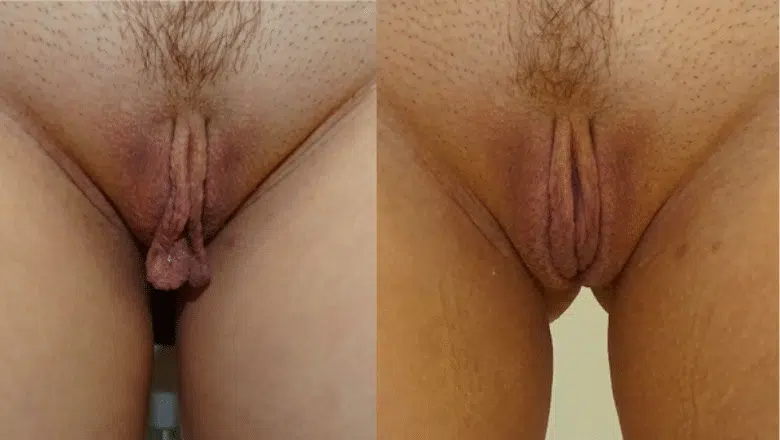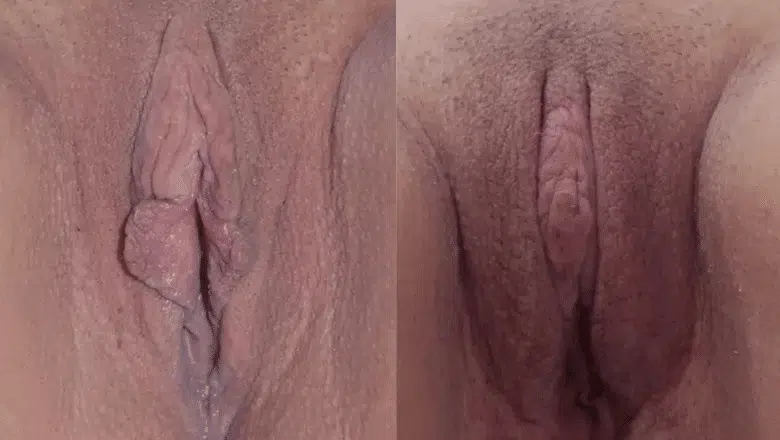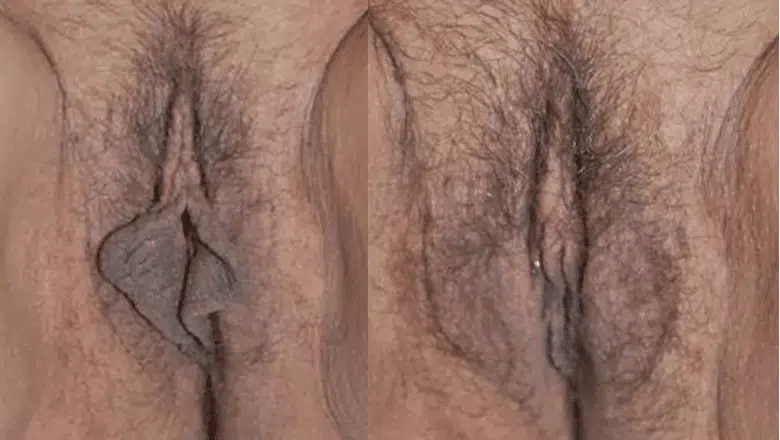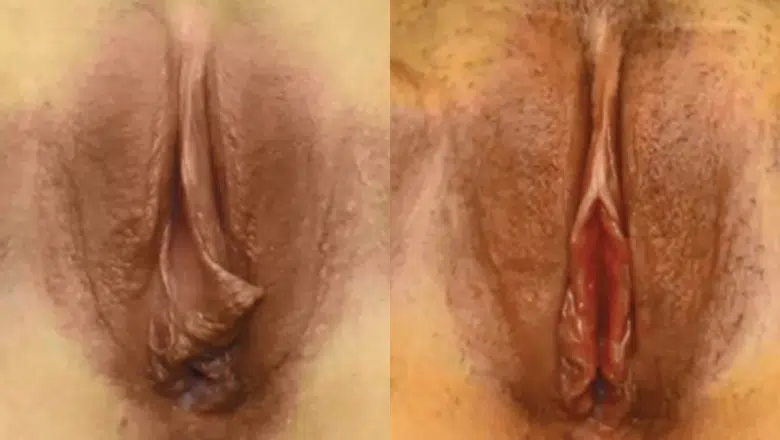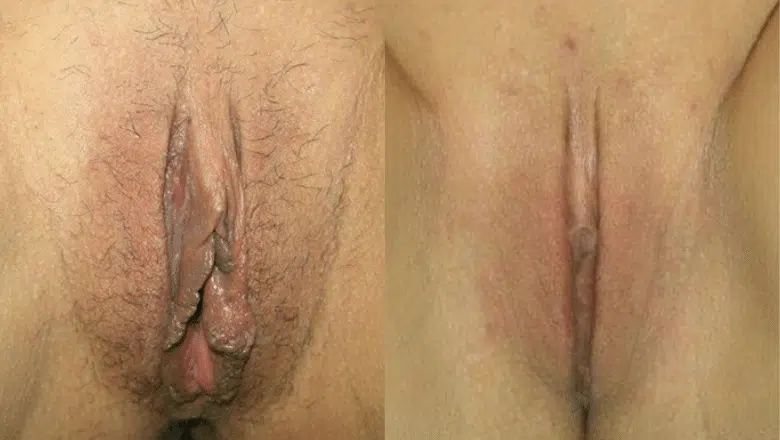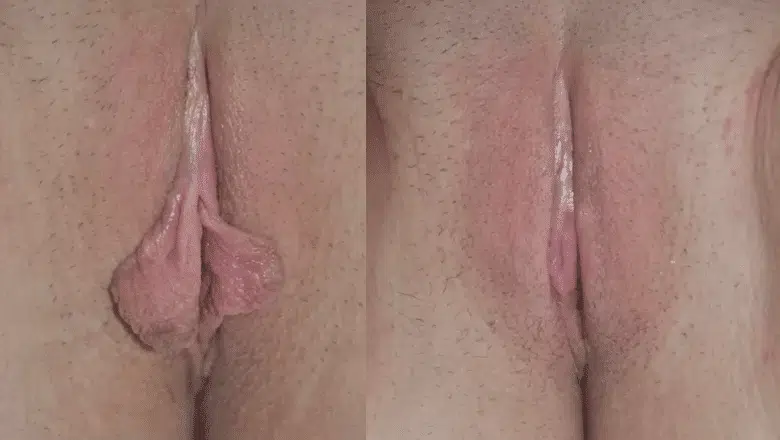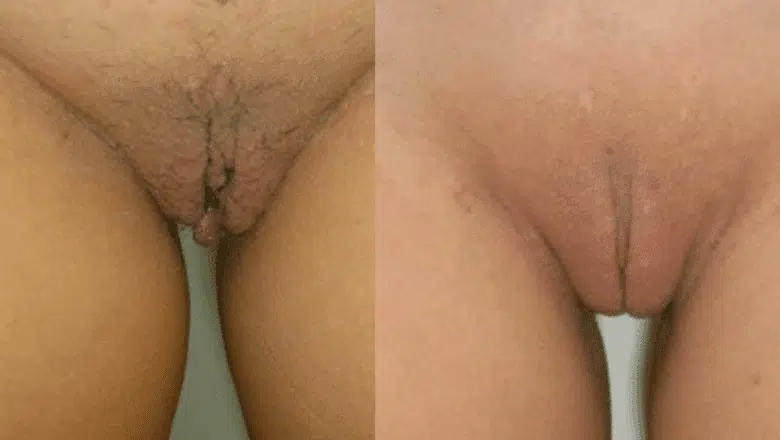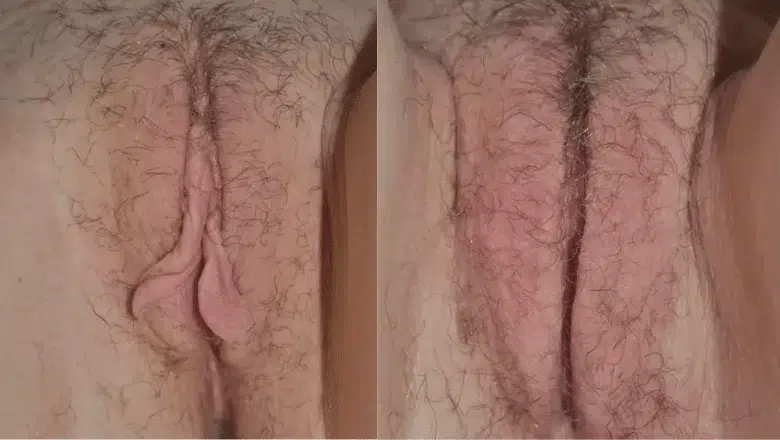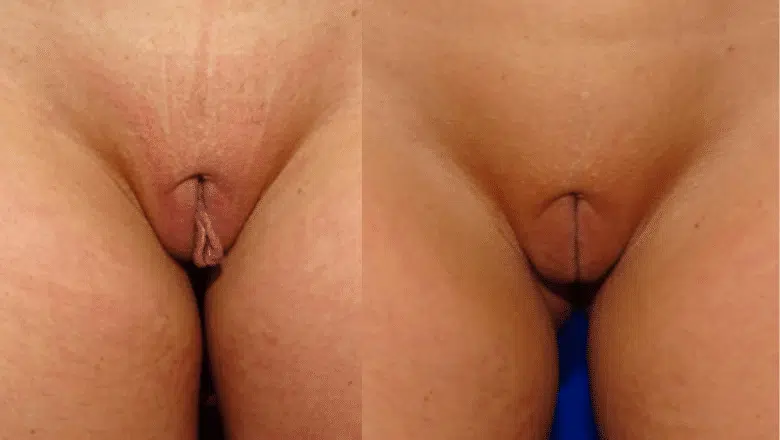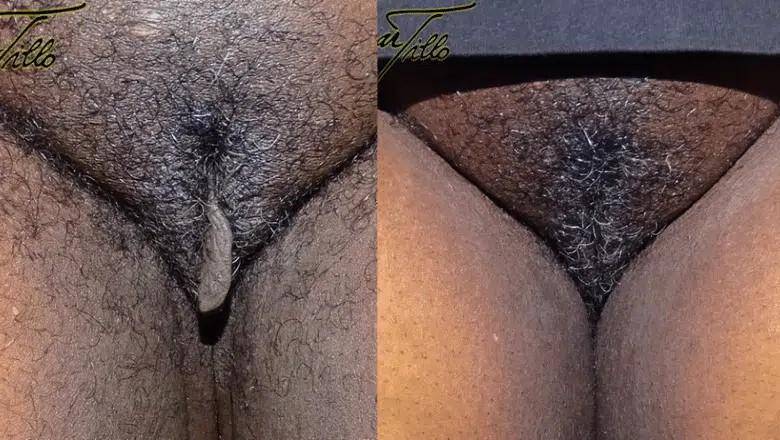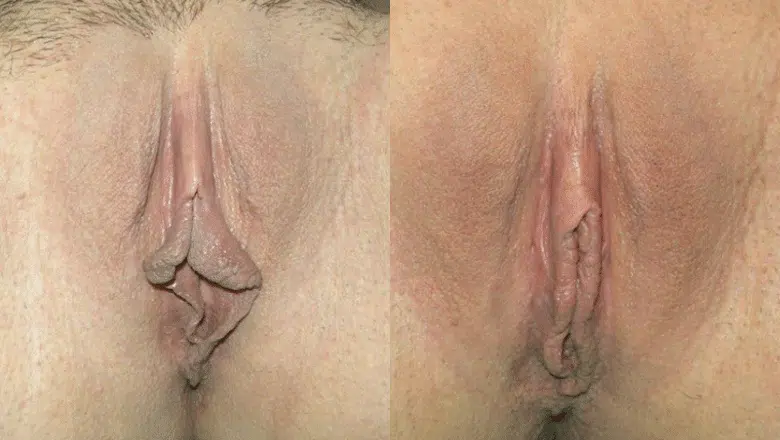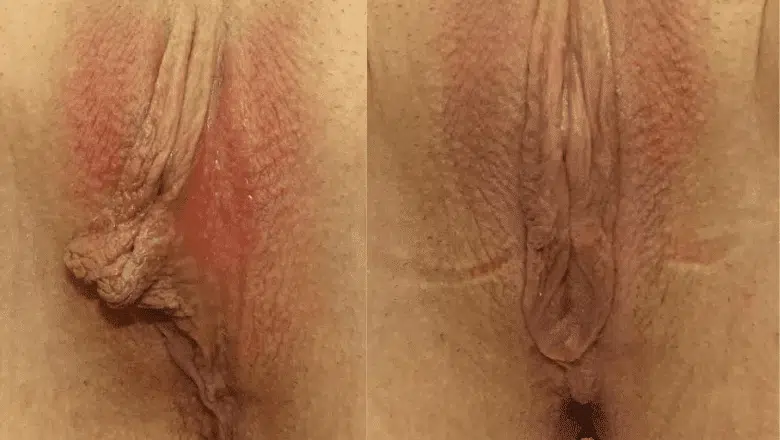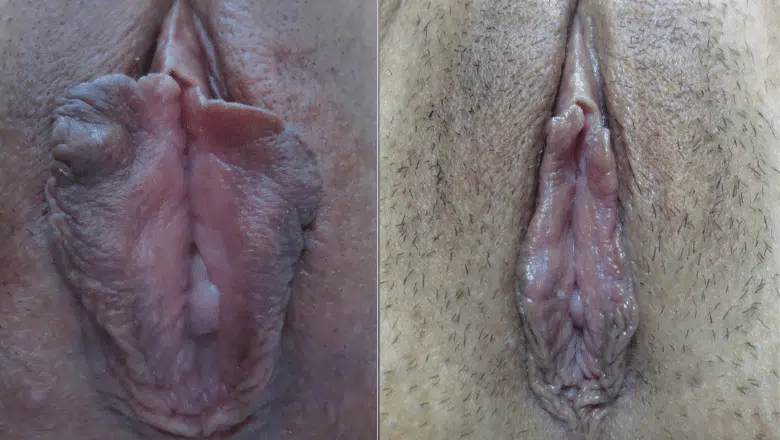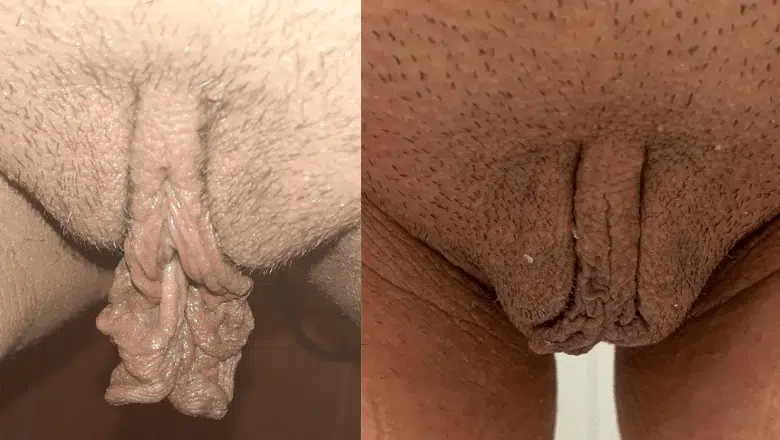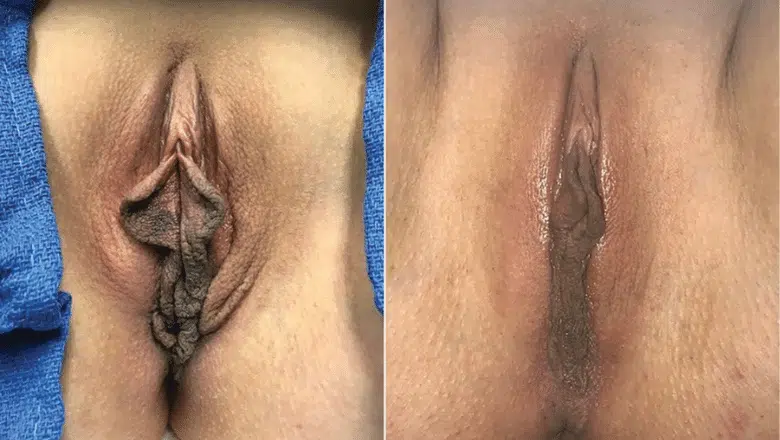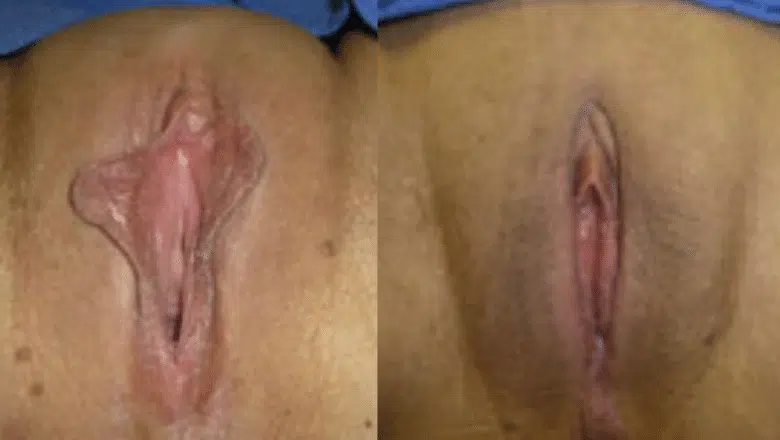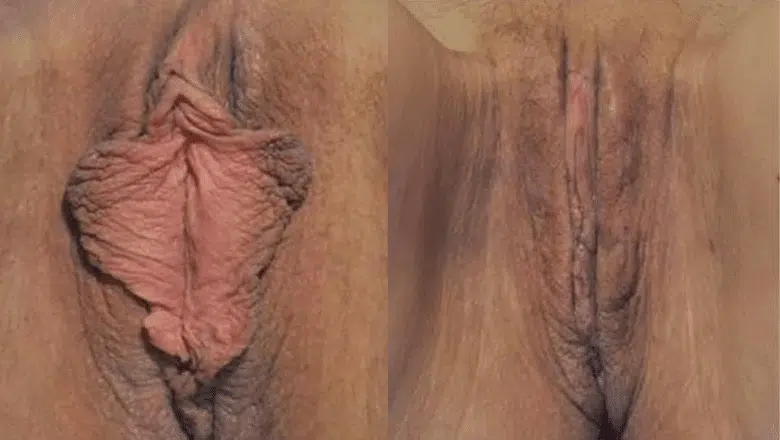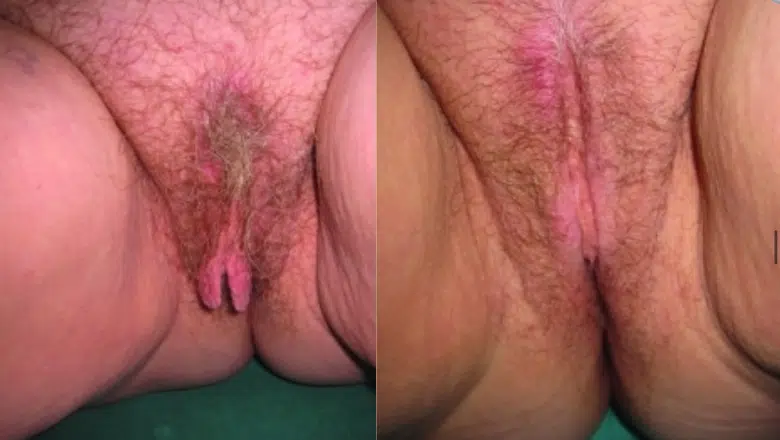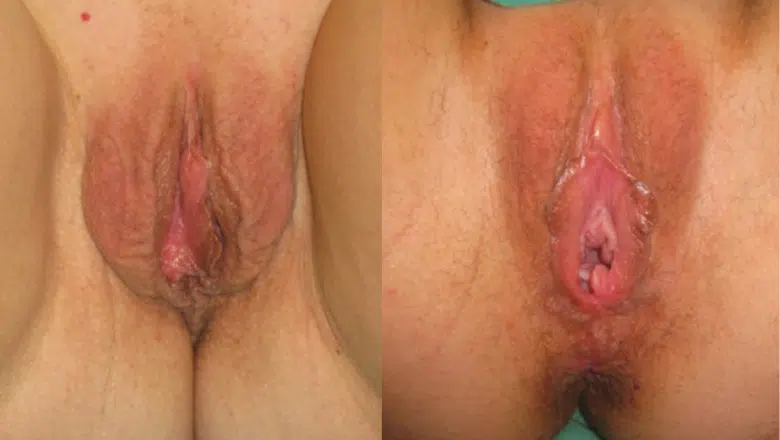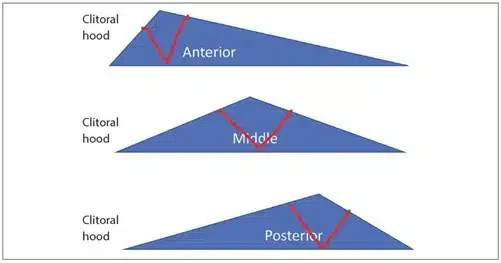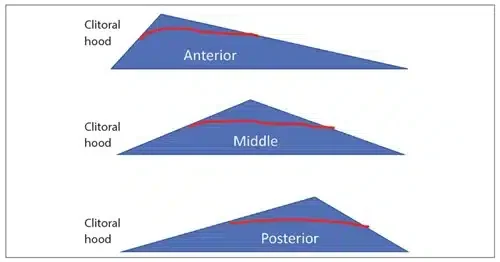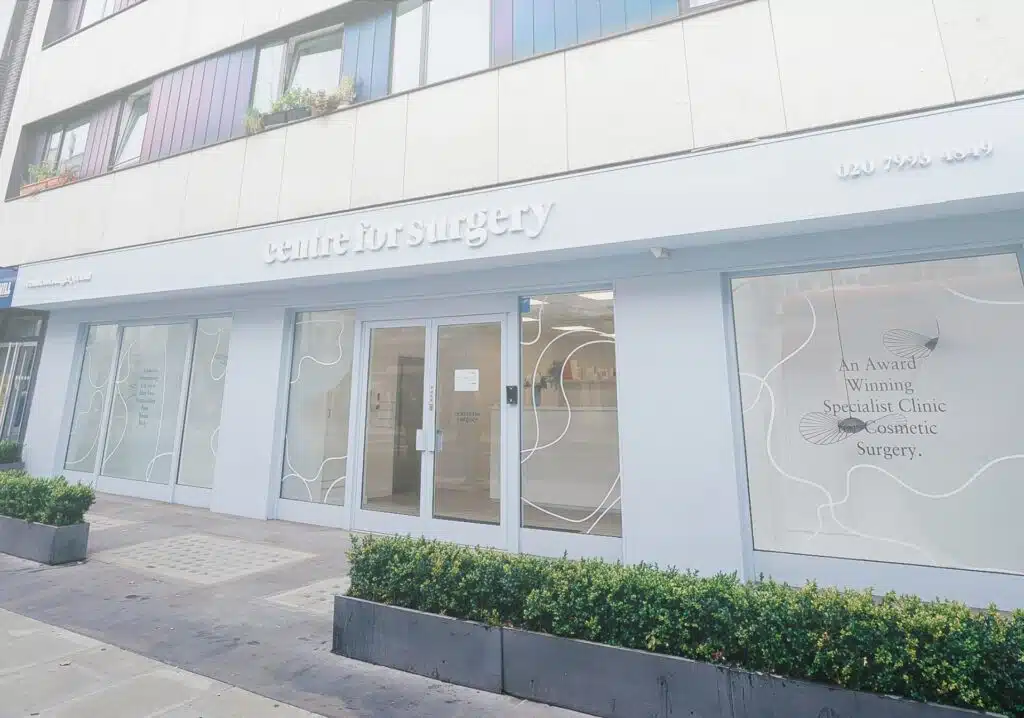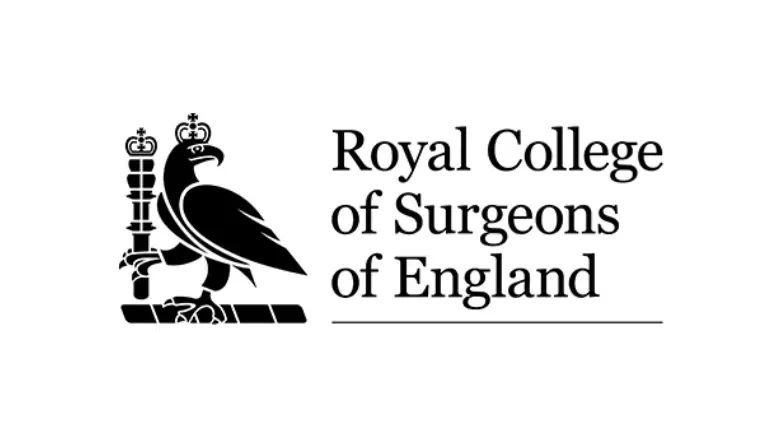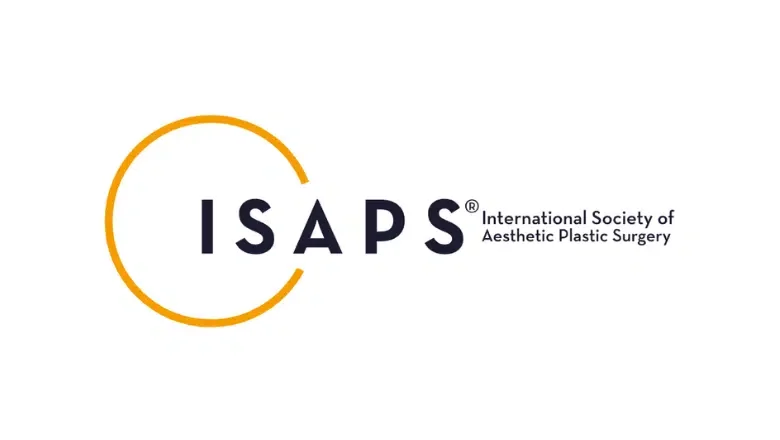Labiaplasty in London
The size and shape of the labia can be a cause for concern for many women who are unhappy with the appearance of enlarged or misshapen labia. There are two types of labia: labia minora and labia majora. The labia minora are the inner folds that sit on either side of the vagina opening, and the labia majora are the outer folds surrounding the inner labia minora. Large labia, also known as labial hypertrophy, may develop due to genetics, after childbirth or as part of the ageing process. Labiaplasty, also known as labia reduction, is a highly effective and safe procedure for a permanent reduction in the size of the labia with an improvement in overall shape and definition.
RELATED: Labiaplasty FAQs – Q&As about Labia Reduction
Labiaplasty surgery or labia minora reduction can reduce the size of enlarged labia minora, which are the inner folds of soft tissue located on either side of the vagina. The best technique involves surgical removal of excess tissue using a scalpel before using fine absorbable stitches to restore the labial edges neatly. Labiaplasty is most commonly performed with a local anaesthetic and sedation, although a general anaesthetic may be chosen if you prefer.
RELATED: What is labiaplasty?
Labiaplasty is also commonly requested to reduce the size of prominent labia majora, which are the outer folds of tissue adjacent to the labia minora. Labia majora reduction is less commonly performed compared with labia minora reduction and requires an experienced surgeon to carry it out successfully. Labiaplasty is commonly confused with vaginoplasty. Labiaplasty is not designed to tighten the vagina. Vaginoplasty, also known as vaginal tightening surgery is the best technique to treat a loose vagina after childbirth by tightening the vagina. Women may choose to undergo labia surgery to improve the appearance of the labia, or they may have functional symptoms from having large labia, which include pain and discomfort whilst carrying out physical exercise or during sexual intercourse.
RELATED: What is labia reduction?
For many adult women, enlargement of the labia minora and/or labia majora can cause aesthetic, functional or psychological issues. Women with enlargement of one or both sides of the labia minora may report increased irritation, inflammatory changes, reduced personal hygiene during menses, and painful intercourse. Many women with labia minora enlargement or asymmetry also report increased anxiety or self-consciousness, embarrassment or feelings of being insecure in sexual relationships or when wearing tight clothing. This has resulted in more requests for aesthetic surgery of the labia minora and/or labia majora. Specialist surgeons at Centre for Surgery perform labia reduction surgery to improve the labial appearance, address functional aspects, and alleviate psychological concerns. Labiaplasty can also address the outer labia, or the labia majora.
RELATED: Labiaplasty and vaginal rejuvenation – what is a normal labia or vagina?
Our specialists carry out 150 to 200 labia reduction procedures each year, making us one of the most experienced labiaplasty centres in London and the UK. We are dedicated to treating all labiaplasty patients with dignity to ensure they feel safe and comfortable with this highly delicate and private surgery.
There are three main types of labiaplasty procedures:
- Labia minora reduction
- Labia majora reduction
- Clitoral hoodectomy
| Labiaplasty | Fast facts |
|---|---|
| Procedure time ⏳ | 1-2 hours |
| Anaesthetic type 💉 | Local anaesthetic or general anaesthetic |
| Length of stay 🛏 | Day case |
| Up and mobile 🚶🏻♂️ | 1 day |
| Washing 🛁 | 1 week |
| Travel ✈️ | 4 weeks |
| Sexual activity ❤️ | 6 weeks |
| Driving 🚗 | 1 - 2 weeks |
| Postoperative garment 👕 | 3 days |
| Sleeping 😴 | On back for 3 days |
| Exercise 🏃🏽♀️ | 6 weeks |
| Full recovery 🕺🏻 | 6 weeks |
| Final results 😃 | 6 months |
What is Labiaplasty?
Labiaplasty is a surgical procedure designed to improve the aesthetics of the vulva, which is the outer portion of the female genitalia. The vulva, visible to the naked eye, is often mistakenly referred to as the ‘vagina’, though technically, it represents only the external component of the female reproductive system.
RELATED: Common Questions about Labia Reduction
A significant part of the vulva is constituted by the labia, also known as the vaginal lips. This anatomical feature can be further divided into two categories:
The Labia Minora, which are the smaller, inner folds of the vulva, are the ones most commonly addressed in cosmetic procedures. These petite, fleshy protrusions can be larger in some women, leading to cosmetic dissatisfaction. Additionally, their size might cause discomfort or even injury during sexual intercourse due to potential interference. A labiaplasty procedure allows for the reduction of the labia minora to a size that is preferable to the individual.
On the other hand, the Labia Majora, the larger, outer folds of the vulva, are less frequently a cause for cosmetic worry. They resemble the skin in texture and are therefore less likely to necessitate surgical correction.
Apart from the labia, the vulva also includes the vaginal opening, the urethral opening, and the clitoral hood. However, these elements of the female genitalia are not typically the focus of plastic surgery related to this area. It is important to note that the main objective of a labiaplasty is to enhance the overall appearance and function of the vulva, thereby improving the quality of life for the individual undergoing the procedure.
What causes labia to become oversized?
The labia minora, which are the inner folds of skin surrounding the vaginal opening, can become enlarged for a variety of reasons, including:
Genetics
Some women are born with labia, which is naturally larger than average.
Hormonal changes
Hormonal changes during puberty, pregnancy, or menopause can cause the labia to enlarge.
Childbirth
Childbirth can stretch and enlarge the labia.
Ageing
As women age, the labia may become more elongated and enlarged.
Obesity
Being overweight or obese can cause the labia to enlarge.
Sexual activity
Sexual activity, especially rough or frequent sex, can cause the labia to enlarge.
Trauma or injury
Trauma or injury to the labia can cause them to enlarge.
It’s important to note that labia size and shape can vary widely, and no “normal” size or shape exists. However, if your labia are causing discomfort, pain, or embarrassment, it may be worth considering labiaplasty to improve the appearance and comfort of your labia.
Labiaplasty Before & After Photos
Browse our labiaplasty photo gallery to see the results achieved by our surgeons at Centre for Surgery. The before and afters below sample the patient photos we have on file. When you come to see us for a consultation, a wide variety will be available. At Centre for Surgery, we only show photos of our patients that have given written consent to use their images on our website. At your consultation, you can also view an extensive range of patient before and after photos.
RELATED: LABIAPLASTY BEFORE & AFTER PHOTOS
Labia reduction surgery can enhance the appearance of your labia, lead to an improvement in self-confidence and make you feel more comfortable about yourself. We advise all patients who are considering having labia surgery to think about their expectations for what they wish to achieve and to discuss this with your labiaplasty surgeon. The results of labia reduction surgery are both permanent and significant. Patients with realistic expectations will have a higher likelihood of being very pleased with their new appearance.
Benefits of Labia Reduction
Labiaplasty, as a surgical procedure, can offer a host of benefits. These benefits may vary from person to person, depending on their reasons for undergoing the procedure. Here are some of the potential benefits:
Improved Appearance
One of the primary reasons women opt for labiaplasty is to improve the aesthetic appearance of their vulva. This procedure can help women gain a more symmetrical and balanced look, boosting their self-confidence and body image.
Increased Comfort
Enlarged labia can cause discomfort during routine activities such as exercise, cycling, or even while wearing tight clothing. By reducing the size of the labia, labiaplasty can significantly improve physical comfort.
Enhanced Sexual Satisfaction
Excessive labial tissue can interfere with sexual activity, leading to discomfort or pain. Labiaplasty can help in reducing this excess tissue, thus improving sexual comfort and satisfaction.
Psychological Well-being
Dissatisfaction with the appearance of one’s labia can lead to embarrassment, self-consciousness, or even anxiety in intimate situations. By improving the appearance of the labia, labiaplasty can help in reducing these psychological concerns, leading to improved mental well-being.
Relief from Physical Symptoms
In certain cases, enlarged labia can lead to symptoms such as chronic irritation, hygiene issues, or urinary tract infections. Labiaplasty can reduce the size of the labia to alleviate these symptoms.
Boosted Self-Esteem
Body dissatisfaction can significantly impact a woman’s self-esteem. By addressing this concern, labiaplasty can contribute to improved self-esteem and overall quality of life.
What Conditions Can Labiaplasty Target?
Labiaplasty is a surgical procedure that can correct several conditions related to the labia minora, which are the inner folds of skin surrounding the vaginal opening. Some of the most common conditions that labiaplasty can correct are:
Enlarged labia minora
The labia minora can become elongated or enlarged for a variety of reasons, including genetics, ageing, childbirth, or hormonal changes. This can cause discomfort, pain, or embarrassment, especially during physical activities such as exercise or sexual intercourse. Labiaplasty can reduce the size of the labia minora to improve comfort and appearance.
Irregular labia shape
The labia minora can also have an irregular shape, with one side longer or wider than the other. This can cause discomfort, irritation, or embarrassment. Labiaplasty can reshape the labia minora to achieve a more symmetrical appearance.
Chafing or rubbing
Enlarged or irregular labia can cause chafing or rubbing, especially during physical activity. This can lead to discomfort, pain, or infection. Labiaplasty can reduce the size of the labia minora to reduce the risk of chafing or rubbing.
Discomfort or pain during sexual intercourse
In some cases, enlarged or irregular labia can cause discomfort or pain during sexual intercourse. Labiaplasty can reduce the size or reshape the labia minora to improve sexual comfort and pleasure.
Embarrassment or self-consciousness
Women with enlarged or irregular labia may feel self-conscious or embarrassed about the appearance of their labia. This can impact their self-esteem and sexual confidence. Labiaplasty can improve the appearance of the labia minora to increase self-confidence and self-esteem.
RELATED: Medical Reasons to Consider Labiaplasty
Labiaplasty is not only carried out for cosmetic reasons. If you are experiencing discomfort or pain related to the size or shape of your labia minora, labiaplasty can help relieve symptoms. The best way to determine if labiaplasty is right for you is to have a consultation with a qualified cosmetic gynaecologist who specialises in genital surgery. The surgeon will be able to examine your labia, discuss your concerns and goals, and determine if the procedure is appropriate for you.
Am I Suitable?
Labiaplasty is a surgical procedure that reduces the size or shape of the labia minora (the inner folds of skin surrounding the vaginal opening). Women who are considering labiaplasty may have concerns about discomfort or embarrassment caused by the size of their labia or may have experienced pain or irritation during physical activity.
The best way to determine if you are suitable for labiaplasty is to have a consultation with a qualified plastic surgeon who specializes in genital surgery. During the consultation, you can discuss your concerns, and the surgeon can examine your labia to determine if the procedure is appropriate for you.
There are a few factors that can affect your suitability for labiaplasty, including:
Medical history
If you have certain medical conditions, such as uncontrolled diabetes, you may not be a suitable candidate for labiaplasty.
Age
Most women who undergo labiaplasty are adults, but there is no age limit for the procedure.
Pregnancy and childbirth
Pregnancy and childbirth can change the size and shape of the labia, and labiaplasty may not be recommended if you are pregnant or planning to become pregnant in the near future.
Expectations
It’s important to have realistic expectations about the outcome of labiaplasty. The procedure can improve the appearance and reduce discomfort, but it won’t change your sexual function or sensation.
Expected Results
- Surgical removal of redundant labial tissue on one or both sides to create a more balanced and aesthetically pleasing look to the labia minora and labia majora
- Reduction in discomfort when wearing tight-fitting clothing or when undertaking sporting activities
- Labiaplasty may improve sexual function by alleviating discomfort during sexual intercourse – a commonly reported reason for having labiaplasty at Centre for Surgery.
How to Prepare
At Centre for Surgery, we understand that discussing the issue of enlarged labia can be both delicate and awkward. From your first phone call to one of our experienced patient care coordinators to your consultation at our Baker Street clinic, our team will take your concerns seriously and will treat you with kindness, consideration and dignity as we do with all of our labiaplasty patients.
RELATED: How to Prepare for Labiaplasty Surgery
Patients who smoke will be advised to stop for at least two weeks before the date of their labiaplasty procedure. Smoking has detrimental effects on microcirculation and is known to slow the wound healing process. All medications, prescribed and over-the-counter, will be reviewed. Aspirin and aspirin-containing medicines should be stopped both before and after surgery. Aspirin and NSAIDs impair the body’s natural clotting process and may cause bleeding complications after surgery. If you require pain relief after surgery, paracetamol is advised.
Whether your procedure is performed under a local or general anaesthetic, it is mandatory to have a responsible adult escort take you home in a car or taxi. You must not travel home on public transport after labiaplasty surgery.
Trim vs Wedge Labiaplasty
RELATED: Comprehensive Overview of Labiaplasty Techniques: What You Need to Know
Wedge Labiaplasty
Wedge labiaplasty is a surgical technique used to reduce the size of the labia minora (the inner vaginal lips). This procedure is designed to improve the appearance of the genital area and to relieve discomfort or pain caused by enlarged or irregularly shaped labia.
The wedge labiaplasty technique involves making a V-shaped incision in the labia minora, removing a wedge of tissue, and closing the incision with sutures. This technique is typically performed under local anaesthesia or intravenous sedation and takes approximately 30 to 60 minutes to complete.
The advantages of wedge labiaplasty include a shorter recovery time, minimal scarring, and improved sensation in the genital area. However, as with any surgical procedure, there are potential risks and complications, including infection, bleeding, and changes in sensation.
Trim Labiaplasty
Trim labiaplasty is a surgical technique used to reduce the size of the labia minora (the inner vaginal lips). This procedure is designed to improve the appearance of the genital area and to relieve discomfort or pain caused by enlarged or irregularly shaped labia.
The trim labiaplasty technique involves making a straight incision along the edge of the labia minora, removing a strip of tissue, and closing the incision with sutures. This technique is typically performed under local anaesthesia or intravenous sedation and takes approximately 30 to 60 minutes to complete.
RELATED: Trim Labiaplasty vs Wedge Labiaplasty
Deepithelialisation technique
For mild to moderate labial tissue resection, the de-epithelialisation technique may be an appropriate option. The technique reduces the length of the labia whilst also preserving the labial border. This can create a more aesthetically pleasing appearance in addition to correcting the functional symptoms that many women experience. The downside is that it is only applicable for very small degrees of labia minora enlargement.
Whichever technique is used, once the desired level of correction has been achieved to achieve a youthful appearance, our surgeons use absorbable sutures to ensure correct healing. With extensive experience as a skilled cosmetic gynaecologist, our surgeons are familiar with the diverse range of labia minora and labia majora appearances and no one technique can be used in a blanket fashion for every patient. The key is a thorough evaluation in a private consultation to develop a customised treatment plan based on a patient’s main concerns.
What is the best technique?
Your surgeon will discuss with you the most appropriate labiaplasty technique based on extensive experience in labiaplasty surgery.
Procedure Details
Labiaplasty is a highly specialised surgery and requires tremendous attention to detail. If you choose to have the procedure under a local anaesthetic, you will also have the option of oral sedation, which may make you feel sleepy and, hence, feel more relaxed before the injection of local anaesthetic. For some cases, the surgeon may recommend a general anaesthetic, and you will then be asleep throughout the procedure under the expert supervision of an anaesthetist. With any technique, you should not feel any pain or discomfort during the procedure as the area is injected with local anaesthetic before the procedure starts. The decision to have local or general anaesthesia is always your choice, although your surgeon may recommend a general anaesthetic in complex or revision cases.
How long does labiaplasty take?
Labiaplasty is typically performed as an outpatient procedure and takes between one and two hours to complete. The exact length of the procedure will depend on several factors, including the extent of the labia reduction, the patient’s anatomy, and the surgeon’s technique.
RELATED: Is labiaplasty painful?
The surgeon will discuss with you the desired length of the labia minora to be removed, and the area will then be marked with your assistance using a hand mirror prior to the procedure. Additionally, it is important to discuss whether clitoral hood reduction is required. When deciding on the degree of tissue to be excised, the area is marked conservatively to prevent over-reduction. Most surgeons agree and believe it is always better to slightly under-correct to avoid the risk of overcorrection, which is very difficult to treat successfully.
The labiaplasty procedure involves reshaping the labia minora using precise dissection techniques. Any unwanted tissue is accurately removed. There are several surgical methods available for labiaplasty surgery. Your surgeon will discuss with you the most appropriate technique applicable to you.
Recovery after Labiaplasty
After the labiaplasty procedure, you may experience some pain and discomfort in the genital area. Bruising and swelling are common side effects. This may last for several weeks. You can use ice packs to reduce swelling or take pain medication to help alleviate discomfort.
RELATED: How to reduce labiaplasty swelling
You will be advised that you should wear a pad – not tampons – for one week or until any bleeding stops. It is also recommended to wear loose cotton underwear during this time. You may find that during recovery after surgery, passing water may be slightly uncomfortable, although this is temporary in nature. The sutures used for labiaplasty surgery are fully dissolvable and will be naturally absorbed by the body. The vast majority of patients tell us that the procedure was much less painful and was much easier than they thought it might be.
RELATED: What is labiaplasty recovery like?
You may need to take about 3-5 days off work, and you will have to avoid any heavy exercise for ten days. You will be able to resume your normal sexual activity about six weeks later. It is important to keep the genital area clean during the recovery period in order to reduce the risk of infection occurring. You should wash the area with soap and water on a regular basis and light sanitary pads for the first seven days. All of our labia reduction patients receive a prescription for pain relief medication. However, many patients remark that they did not require any pain relief as there is very little pain associated with labia reduction. An antibiotic ointment should be applied to the area twice daily after your procedure.
RELATED: Labiaplasty Stitches – What to Expect
Is recovery painful?
Labiaplasty is a surgical procedure that can cause some discomfort and pain during the recovery period. However, the extent of the pain and discomfort will depend on several factors, including the patient’s overall health, the extent of the labia reduction, and the surgeon’s technique.
Immediately after the procedure, the patient may experience some pain, swelling, and bruising in the area. The surgeon will usually prescribe pain medication to manage this discomfort. Most women find that over-the-counter pain medication is sufficient, but more severe pain can be managed with prescription pain medication.
The swelling and bruising will typically peak within the first few days after the procedure and then begin to subside. Ice packs or a cooling device can be used to reduce swelling and discomfort during this time.
In the first week after the procedure, the patient may experience some itching, burning, and discomfort in the area. This is normal and can be managed with over-the-counter pain medication or prescription pain medication.
As the swelling and discomfort begin to subside, the patient may begin to feel more comfortable. Most women are able to return to work and other normal activities within a few days, although they should avoid strenuous activity and sexual intercourse for several weeks after the procedure.
It’s important to follow the surgeon’s postoperative instructions carefully to ensure a smooth recovery and optimal results. This may include avoiding certain medications, taking antibiotics to prevent infection, and wearing a special dressing or support garment to protect the area.
Aftercare Tips
Ensuring a smooth recovery process following a labiaplasty procedure is crucial, and there are several steps you can take to promote healing and minimise discomfort. Here are some aftercare tips to keep in mind:
Avoid Tampons
After a labiaplasty, it’s recommended to use sanitary pads instead of tampons. Inserting a tampon could potentially irritate the surgical site and disrupt the healing process.
Sitz Baths
Incorporate daily sitz baths into your routine to help reduce swelling and alleviate discomfort. A sitz bath involves sitting in a shallow bath of warm water, often with added salt, which can have a soothing effect on the surgical area.
Ice Packs
To help manage swelling and pain, consider applying ice packs to the area. Remember to place the ice pack on your underwear rather than directly on the skin to prevent frostbite, and limit each application to 15-20 minutes at a time.
Elevate Your Behind While Sleeping
When lying down, elevate your behind using a few small pillows. This can help reduce swelling by improving blood flow and fluid drainage from the surgical area.
Loose Clothing
During your recovery period, opt for loose-fitting clothes. Tight clothing could potentially restrict blood flow to the surgical site, hindering the healing process.
Potential Risks of Surgery
Our surgeons have many years of experience performing cosmetic gynaecology procedures, including labiaplasty and labia reduction. They regularly attend conferences overseas to learn about the best and safest ways of performing these procedures. The labiaplasty surgery performed today is very different from that performed even 20 years ago, which is why it is so important for our surgeons to keep abreast of changes in the field. Despite everything being done to ensure procedures run smoothly, there is always a small chance of complications occurring.
Patients should always start by making sure they choose a skilled surgeon to get the results that fit with their treatment goals. It is also very important to comply with all the postoperative aftercare instructions and restrictions on activity, which are vital to ensure speedy healing. During your consultation, the potential risks and complications that can occur with labiaplasty will be discussed. The following are some but not all potential risks associated with labia reduction surgery. Most patients who have labiaplasty surgery never experience these risks as they are quite rare.
Some of the common risks and complications associated with labiaplasty include:
Infection
Infection is a rare but possible complication of labiaplasty. Symptoms of infection include redness, swelling, and discharge from the incision site. Antibiotics may be required to treat the infection.
Scarring
Scarring is a common side effect of labiaplasty, and the scars may be visible or palpable in the labia. The scars may be red, raised, or uncomfortable for several months after the procedure, but they will typically fade over time.
Bleeding
Bleeding is a rare but possible complication of labiaplasty. The patient may require additional surgical intervention to control the bleeding.
Pain
Pain is a common side effect of labiaplasty, and the patient may experience some discomfort and pain during the recovery period. Pain medication may be required to manage the pain.
Numbness
Numbness is a rare but possible complication of labiaplasty. The patient may experience some numbness in the area due to nerve damage, but this typically improves over time.
Unsatisfactory results
In some cases, the results of labiaplasty may not meet the patient’s expectations, and additional surgical intervention may be required to correct the problem.
Changes in sexual function
Labiaplasty can affect sexual function, and the patient may experience changes in sensation or sensitivity in the area.
Revision surgery
Revision surgery may be required if the patient is not satisfied with the results of labiaplasty.
RELATED: What is a revision labiaplasty?
How Much Does Labiaplasty Cost?
Our team of highly skilled surgeons at Centre for Surgery have had the privilege of working with numerous women seeking labia reduction surgery. Their vast experience has led them to deeply appreciate the significance of this procedure in the lives of many women. Enlarged labia can lead to both physical discomfort and emotional distress, and we are here to help mitigate these concerns. Labiaplasty starts from £2995.
In the past, we have encountered numerous patients who initially believed this procedure might be financially out of reach. However, we’re proud to note that our accessible financing options at Centre for Surgery have made this transformative procedure a feasible and affordable choice for many. We believe that everyone deserves to feel comfortable and confident in their own body, and we strive to make this a reality for as many women as possible.
Centre for Surgery is committed to providing top-tier care that respects your needs and concerns. We’ll work closely with you to help you understand the costs associated with labia reduction surgery, and we’ll guide you through the various financing options available. Our ultimate goal is to make this process as seamless and accessible as possible so you can focus on your journey towards improved comfort and self-confidence.
Several factors will determine the overall cost of your labiaplasty procedure, and the final quotation will be given after your face-to-face consultation. Our specialists can advise you on what the procedure involves and what can be achieved. Many women who have successfully undergone labiaplasty surgery with us have often remarked that they thought this procedure would be well out of their price range. Still, thanks to our financing options, the procedure has become achievable and affordable.
RELATED: How much does a labiaplasty cost?
Many women choose to have labial surgery combined with a vaginal tightening procedure for comprehensive vaginal rejuvenation. The cost would be higher for a combined labiaplasty and vaginoplasty procedure.
- Labia minora reduction alone or combined labia minora reduction + labia majora reduction
- Anaesthesia cost – local anaesthetic or general anaesthetic
- Any previous surgery to the area
What is included in my treatment package?
- As many preoperative consultations with your surgeon as you like to make sure the labia reduction procedure is right for you
- Treatment at a specialist day surgery facility recently rated ‘Good’ by the CQC
- Enhanced same-day discharge with the added benefits of recovering in your own home
- 24/7 clinical support from your surgeon for the first 48 hours and our expert postoperative support team
- Your very own dedicated patient coordinator
- In-depth preoperative medical assessment to make sure you are fully fit for your procedure
- Exceptionally high standards of postoperative care described as ‘outstanding’ by the CQC with regular telephone and face-to-face checks.
CALL US TODAY TO GET LABIAPLASTY PRICES
Finance options for labiaplasty, including 0%
Centre for Surgery is fully approved to offer finance for labiaplasty via our specialist finance partner, Chrysalis Finance. You no longer need to use your savings to pay for your treatment – you can apply to spread the cost of your procedure with Chrysalis Finance using their simple 1,2,3 application to pay for it. Don’t wait until you have enough money for your treatment. Apply today and (subject to status) pay for your procedure quickly in monthly instalments using one of their payment options. Chrysalis Finance is the only ethical provider focusing solely on providing specialist financing for medical procedures. Speak to one of our patient coordinators today to learn about labiaplasty finance.
How to Choose the Best Surgeon
RealSelf Top Doctors for labiaplasty
RealSelf’s top doctor status is awarded to less than 10% of the RealSelf doctor community. This status is earned by achieving consistently high patient satisfaction (from RealSelf reviews), getting excellent feedback on expert answers to patient questions, and investing significant time in Q&A and other doctor activities.
How do you find the Best Surgeon in London?
When considering having labiaplasty surgery, seeking a highly qualified and experienced surgeon with many years of experience is vital. The ideal surgeon should be fully trained in all techniques of labia surgery, including the trim, wedge, and deepithelialisation methods. They should be able to match the correct technique to your presenting condition. They should also be highly skilled in managing all labiaplasty surgery’s potential risks and complications.
The face-to-face consultation is an ideal opportunity to explain what happens before, during, and after the procedure. Many patients are concerned about possible pain during the recovery period. Your surgeon will be able to explain all the pain management strategies that can be used to optimise your recovery.
Many patients ask us who the best specialist for labiaplasty surgery is. Gynaecologists and plastic surgeons are the two types of doctors who perform labiaplasty surgery. We believe that both types of doctors are well-trained to perform labiaplasty surgery as they are specialists in the female genitalia and do not perform any other type of cosmetic surgery, such as rhinoplasty, breast augmentation, or liposuction.
Surgeons who perform labia reduction surgery should have an extensive collection of before-and-after photos for you to view. These photos can help you form an accurate impression of how you could look after surgery. You should also view patient testimonials on accredited review websites such as Trustpilot.
Patient selection is a fundamental component of achieving excellent outcomes following surgery. The skilled surgeon will consider your overall mental and physical health when deciding on your suitability for labiaplasty surgery. Patients who have chronic uncontrolled medical conditions may not be ideal candidates for labiaplasty, and your surgeon should be able to identify this and advise you against surgery.
Specialist doctors who carry out labiaplasty surgery should be on the GMC specialist register, which you can check on the GMC website. Surgeons should also belong to a specialist organisation such as the European Academy of Aesthetic Gynaecology or the British Association of Aesthetic Plastic Surgeons (BAAPS).
Why Choose Centre for Surgery?
Quality, Experience, and Unmatched Care
When it comes to highly personalised and sensitive procedures such as Labiaplasty, the choice of your healthcare provider matters enormously. Centre for Surgery, located at the heart of London, is a leading specialist in plastic surgery and offers a comprehensive, patient-focused approach that sets us apart.
Our Expertise
Our team of renowned surgeons have years of experience and are trained in the most advanced techniques. This ensures not just an aesthetic result, but also functional outcomes that make a real difference in the quality of your life.
Tailored Approach
Every patient is unique. At Centre for Surgery, we offer bespoke treatment plans that are tailored to your individual needs and aesthetic goals.
State-of-the-Art Facilities
Our clinic boasts state-of-the-art facilities and medical equipment, meeting the stringent UK healthcare regulations, to ensure you receive the best possible care in a comfortable, hygienic setting.
Patient Testimonials
“The entire process was incredibly smooth, and I felt supported from the first consultation to the post-surgical follow-ups. Thank you Centre for Surgery for helping me regain my confidence.”
– Emily S.
“The doctors are extremely knowledgeable and I knew I was in safe hands. The results are simply amazing!”
– Sarah J.
“Professional, compassionate and outcome exceeded my expectations. I would highly recommend Centre for Surgery for any cosmetic procedure.”
– Mark R.
Contact Us for a Personalised Consultation
If you’re considering Labiaplasty, contact us today to book your consultation.
📞 Phone: 0207 993 4849
📧 Email: contact@centreforsurgery.com
📍 Address: 95-97 Baker Street, London W1U 6RN
To know more about Labiaplasty or any other procedures, check out our Plastic Surgery Blog for a plethora of information and expert opinions.
Choose Centre for Surgery for a life-changing experience crafted just for you.
FAQs
-
What is feminine rejuvenation?Feminine rejuvenation refers to a range of treatments aimed at improving the aesthetic appearance and function of the female genital area. These treatments can address various concerns, such as vaginal laxity, labial asymmetry or elongation, vaginal dryness, urinary incontinence, and sexual dysfunction. The procedures involved in feminine rejuvenation aim to restore a more youthful and desirable appearance, enhance sexual satisfaction, and improve overall well-being.
-
How do normal-looking labia appear?The appearance of female genitalia, specifically the labia, exhibits a wide range of variation among women, and there's no singular standard that defines what is 'normal'. This diversity is an intrinsic part of female physiology. Some women might observe their labia minora, the inner vaginal lips, protruding beyond the labia majora, the outer vaginal lips, during their adolescent years, while others might notice an enlargement of the labia minora post-pregnancy.
In the anatomically traditional sense, the labia majora would fully encompass the labia minora. However, over time and due to factors like aging or childbirth, the labia minora could enlarge and extend beyond the protective cover of the labia majora. This leaves the sensitive mucosal tissue of the labia minora susceptible to friction, potentially causing discomfort, pain, and hygiene-related issues.
The dimensions and form of your labia are primarily dictated by genetics, yet they're also subject to alterations brought about by aging and childbirth. For some women, the labia may revert to their pre-pregnancy state, while for others, the changes might be enduring.
Mostly, these transformations are aesthetic in nature, but in certain cases, they could lead to discomfort. Given the delicate nature of the mucosal tissue in the labia minora, irritation can easily occur due to the friction generated by tight clothing or physical activity. This issue is often endured by women for extended periods, leading to persistent pain, unease, and self-consciousness.
Excessive labial tissue can even create visible outlines through tight clothes or swimwear, leading to further discomfort and diminished confidence. The silver lining, however, is that procedures like labiaplasty can help to streamline the appearance of the labia, thereby bolstering self-assurance and enabling women to wear whatever they feel comfortable in.
Despite the commonality of these issues, conversations around them remain scarce, primarily because of shyness or embarrassment associated with discussing concerns like enlarged or irregular labia, painful intercourse, or constant discomfort. This lack of open dialogue means that many women remain uninformed about potential solutions, thereby enduring these issues in silence for far longer than necessary. -
What are labia?The labia are the soft tissue structures that sit on either side of the vaginal opening. The labia form part of the vulva which is the term used to describe the external genital structures. There are two types of labia, the labia minora which are the inner lips and the labia majora which are the outer lips. The labia have a wide range of appearances across women and can differ significantly both in size and shape. The procedure of labiaplasty is able to address the labia minora and labia majora to change their size and level of symmetry. The most common procedure is labia minora reduction.
Labial reduction surgery is commonly performed for the reduction of large labia minora where their appearance can be a common cause of distress for many women.
The large labia can be effectively reshaped to give a smaller size whether through a trim or wedge technique as part of a labial reduction procedure. -
What is a "Normal Labia"?The concept of a "normal labia" is subjective and varies widely among individuals. In reality, there is a wide range of normal variations when it comes to the appearance of the labia. Labia can be long or short, smooth or slightly irregular, and their size can differ significantly among women. As long as there are no medical concerns such as infections, discomfort, or functional issues, the appearance of one's labia is considered normal.
-
What Problems can Large Labia Cause?Women who have excessively large labia out of proportion to the rest of the vaginal area can cause psychological issues with embarrassment and even depression in some cases.
Many women will have functional impairment from overly large labia. Enlarged labia minora can catch on items of clothing and swimwear in particular. Enlarged labia minora may even be obvious when wearing tight-fitting clothing. Pain with sexual intercourse and exercise can also be caused by enlarged labia minora.
Labia reduction surgery can effectively address any pain or discomfort which results in a significant and permanent improvement in quality of life for women affected by excessively large labia. -
What is Labia Reduction?Labiaplasty also known as labioplasty is a surgical procedure designed to reduce or reshape the size of the labia minora which are the smaller inner lips of the vulval area or the labia majora which are the larger outer lips of the vulval area. A labiaplasty differs from a vaginoplasty which is a surgical procedure designed to tighten the vagina. Labiaplasty is performed on the external genitalia only.
-
How common is labiaplasty surgery?Labiaplasty surgery, which involves altering the size and shape of the labia minora or majora, is a commonly performed procedure within the realm of female genital cosmetic surgery. It has gained popularity in recent years as more women seek to address concerns related to the appearance or discomfort associated with the labia. Labiaplasty is among the most frequently performed procedures within the field of female genital cosmetic surgery.
-
How do you get a labiaplasty?To undergo a labiaplasty procedure, you should start by researching and finding a qualified and experienced surgeon at Centre for Surgery who specialises in labiaplasty. Schedule a consultation to discuss your concerns and goals with the surgeon. During the consultation, the surgeon will evaluate your candidacy for the procedure, explain the details of the surgery, and address any questions or concerns you may have. If you and the surgeon determine that labiaplasty is the appropriate course of action, a surgery date will be scheduled, and you will be provided with preoperative instructions to prepare for the procedure.
-
Who performs labiaplasty surgery?Labiaplasty surgery is typically performed by plastic surgeons who specialise in female genital cosmetic surgery. However, there are also gynaecologists who have received specialised training and perform labiaplasty procedures. It is crucial to choose a qualified and experienced surgeon with a proven track record in performing labiaplasty surgeries. Avoid seeking the procedure from undertrained or inadequately qualified practitioners, often referred to as "cosmetic surgeons," to ensure safe and satisfactory outcomes.
-
What does Labiaplasty address?Labiaplasty primarily addresses concerns related to the size, shape, and symmetry of the labia minora. The procedure aims to reduce the size of elongated or hypertrophic labia, creating a more balanced and aesthetically pleasing appearance. By decreasing the size of the inner labial tissue, the labia minora can be better proportioned and flush with the outer labia, enhancing comfort and self-confidence.
-
What is a Perfect looking Labia?There is no universally defined standard for a "perfect-looking labia." The perception of what is considered perfect or aesthetically pleasing varies among individuals. The goal of labiaplasty is not to achieve a standard of perfection but to address concerns or discomfort that individuals may have about their labia. Through labiaplasty, it is possible to enhance the appearance of the labia according to one's personal aesthetic preferences while ensuring optimal function and comfort.
-
What is the difference between labiaplasty and vaginoplasty?Labiaplasty and vaginoplasty are two distinct types of gynecological cosmetic surgery, each with its own specific purpose and outcome.
Labiaplasty: This procedure primarily focuses on the external parts of the female genitalia, particularly the labia minora and labia majora. Women may choose to have a labiaplasty for various reasons, including discomfort from enlarged labia, issues with hygiene, or dissatisfaction with the appearance of their labia. The procedure typically involves reducing the size of the labia to alleviate these concerns. In some cases, it may also involve reshaping or evening out the labia for cosmetic purposes.
Vaginoplasty: This procedure, on the other hand, is concerned with the internal structure of the vagina. It's often referred to as 'vaginal rejuvenation' or 'vaginal tightening' and is typically sought after by women who have experienced loosening of the vaginal canal due to childbirth or aging. The primary goal of a vaginoplasty is to tighten the vaginal muscles and reduce the size of the vaginal canal, which can enhance sexual satisfaction and also address issues like incontinence.
While both procedures aim to improve the quality of life and boost self-confidence, they address different parts of the female genitalia and different concerns. -
What is the difference between labiaplasty and female circumcision?Labiaplasty and female circumcision (also referred to as female genital mutilation or FGM) are significantly different practices, both in terms of their purpose and the cultural or medical contexts in which they occur.
Labiaplasty: This is a surgical procedure typically performed for medical or cosmetic reasons. It's often chosen by adult women who may be experiencing physical discomfort, hygiene issues, or dissatisfaction with the appearance of their labia. The procedure usually involves reducing the size of the labia minora (inner vaginal lips) or labia majora (outer vaginal lips) and is conducted under anesthesia by a qualified medical professional. Labiaplasty is a voluntary procedure, meaning it's performed only with the informed consent of the individual.
Female Circumcision/FGM: This is a cultural or religious practice that involves the partial or total removal of external female genitalia or other injury to the female genital organs for non-medical reasons. It's often performed on girls between infancy and age 15, typically without anesthesia, and can lead to severe health complications such as chronic pain, menstrual problems, potential childbirth complications, psychological trauma, and increased risk of infections. The practice of FGM is internationally recognized as a violation of human rights of girls and women and is illegal in many countries.
It's important to stress that these procedures are fundamentally different, with labiaplasty being a consensual and often beneficial procedure when performed by qualified medical professionals for valid medical or aesthetic reasons, while FGM is a harmful practice with no health benefits, carried out for cultural or religious reasons, often without consent. -
Why is Labiaplasty Controversial?Labiaplasty is considered controversial because it involves altering the appearance of the female genitalia. The controversy stems from societal norms, cultural beliefs, and misunderstandings surrounding female anatomy. Unfortunately, discussions about female genitalia are often stigmatized or met with misconceptions. However, it is important to recognize that every individual should have the freedom to make choices about their own bodies and pursue procedures that can improve their well-being and self-confidence.
-
Am I suitable for a labiaplasty?Your surgeon will conduct a detailed clinical assessment to determine your suitability for labiaplasty surgery.
The most common reasons to seek labiaplasty include women who are unhappy with the size, shape or the symmetry of the labia. Other women may have functional symptoms including pain and discomfort which affects their ability to carry out physical exercise or sexual intercourse.
Your surgeon will determine suitability for labia reduction surgery by taking a medical history and physical examination. You should have realistic expectations of what can be achieved with labia surgery. -
Should I get a Labiaplasty?The decision to undergo labiaplasty is highly personal and should be based on individual concerns and needs. If you experience physical discomfort, such as rubbing, chafing, or interference with certain activities like wearing tight clothing, engaging in sports, or sexual intercourse due to the size or shape of your labia, labiaplasty may be a suitable option. It is important to consult with a qualified surgeon specialising in labiaplasty at Centre for Surgery to discuss your specific concerns and goals. They will evaluate your individual circumstances, conduct a thorough examination, and provide professional advice on whether labiaplasty is appropriate for you.
-
Who should not have a labiaplasty?While labiaplasty is generally a safe procedure, there are certain factors that may make an individual unsuitable for surgery. Some factors that may exclude someone from undergoing labiaplasty include:
Poor overall health: If you have significant medical conditions that could increase the risks associated with surgery and anaesthesia, it may be advised to avoid labiaplasty until your health improves.
Pregnancy: It is generally recommended to wait until after childbirth to undergo labiaplasty, as pregnancy and childbirth can affect the appearance and function of the labia.
Mental health concerns: It is important to be in a stable mental and emotional state before considering any elective cosmetic procedure. If you are currently experiencing significant psychological distress or have untreated mental health conditions, it may be advisable to address those concerns before proceeding with labiaplasty.
Unrealistic expectations: It is crucial to have realistic expectations about the outcomes of labiaplasty. Understanding that the procedure can enhance the appearance and address certain functional issues, but it may not achieve perfection or solve all concerns, is important. -
How to choose the best labiaplasty surgeonWe would always recommend spending time to research all aspects of the labiaplasty procedure and making sure to choose a qualified surgeon who has many years of experience in carrying out labiaplasty surgery.
The ideal surgeon will have experience in all aspects of the procedure and explain the potential risks and complications of labia reduction surgery. The surgeon should have experience in all the main labiaplasty techniques including the trim method, the wedge method and the epithelialisation techniques. They should be able to assess your expectations for treatment and advise you on the best treatment option for you.
The consultation forms the foundation of effective treatment planning, and it is important for the surgeon to outline what the recovery process involves including the importance of complying with all preoperative and post-operative care instructions.
Labiaplasty surgery is specialist surgery and should be undertaken by a surgeon appropriately skilled in such surgery. You should ask to view before and after photos of patients who may be similar to yourself to give you an idea of how you could look following labia reduction surgery. It is also wise to view patient reviews found on reputable review platforms such as Feedback Company and Trustpilot.
An ethical labiaplasty surgeon will always have the patients physical and mental well-being in mind when deciding on suitability for this treatment. For patients who are not suitable, the experienced surgeon will advise this at the end of your consultation and may recommend a number of suitable alternative treatment options including the option of doing nothing.
In the UK, only doctors who are registered with the GMC with a license to practice can carry out cosmetic surgery. You can check if your doctor is registered with the GMC by checking online at the GMC website. -
What is a bilateral labiaplasty?Bilateral labiaplasty refers to a surgical procedure that addresses both sides (left and right) of the labia minora, which are the inner folds of skin surrounding the vaginal opening. This procedure aims to reshape and reduce the size of both labia minora to achieve a more symmetrical and proportionate appearance.
-
Why do you need Labiaplasty?The need for labiaplasty can arise due to both medical and cosmetic reasons. Medically, labiaplasty may be necessary if you experience functional issues or discomfort caused by elongated or hypertrophic labia. This can include problems such as chronic irritation, chafing, difficulty wearing certain clothing or underwear, interference during sexual intercourse, or hygiene difficulties. On the cosmetic side, some individuals may simply desire to improve the appearance of their labia based on personal preferences and aesthetics.
-
Is it normal to have extra skin down there?Yes, it is normal to have variations in the size, shape, and appearance of the labia. Labia can naturally vary in length, color, and texture among individuals. Having some extra skin or asymmetry is common and does not necessarily indicate a problem or medical condition. However, if you experience discomfort or functional issues related to the excess skin, you may consider discussing your concerns with a healthcare provider or a specialist in labiaplasty.
-
What are the benefits of a trim labiaplasty?The advantages of trim labiaplasty include a straightforward and well-established surgical technique, minimal scarring, and improved sensation in the genital area. However, as with any surgical procedure, there are potential risks and complications, including infection, bleeding, and changes in sensation.
The trim technique is a suitable method for those with larger labia or with significant degrees of asymmetry. The technique creates a straighter appearance along the labial edge and removes the existing labial border. Many surgeons prefer the trim method as problems that can occur following wedge excision techniques, including wound breakdown leading to possible fistula formation, do not occur following the trim excision technique. Our surgeons take great care to perform a conservative excision as over-reduction is a difficult problem to correct. -
Should I get a labiaplasty?There are several candidates who are appropriate for a labiaplasty. Some women have an enlarged labia minora, which can cause painful inflammation, chaffing, and pain during intercourse or while inserting tampons. Women may often have one labia that is larger than the other, with surgery being a good option in this instance.
Having your labiaplasty in London gives you access to specialist female surgeons who perform this surgery on a regular basis and are therefore experienced to manage all aspects of your care. -
Who shouldn’t get a labiaplasty?At Centre for Surgery, no surgery is offered to anyone below the age of 18. At this age, your labia will still be growing and developing and will continue to do so until early adulthood. It is recommended to be over the age of 18 before considering a labiaplasty procedure.
Our surgeons can perform surgery on those with associated functional symptoms such as pain, or excessive chaffing in addition to aesthetic considerations. -
Does labiaplasty make you tighter?Labiaplasty does not make you tighter. This is a common misconception because both labiaplasty and vaginoplasty fall under the umbrella of vaginal rejuvenation procedures, but they serve different purposes.
Labiaplasty is a procedure that primarily focuses on the labia, the external parts of the female genitalia. It involves the reduction, reshaping, or evening out of the labia minora and/or labia majora, typically to alleviate physical discomfort, improve hygiene, or enhance aesthetic appearance.
On the other hand, vaginoplasty, also known as vaginal tightening, is a procedure that aims to tighten the vaginal canal. This is typically performed on women who have experienced a loosening of the vaginal canal due to childbirth, aging, or other factors.
If vaginal tightness is a concern, a vaginoplasty or other specific procedure designed to tighten the vaginal canal may be more suitable. -
Does labiaplasty reduce sensation?Labiaplasty is not intended to reduce sensation in the genital area. In fact, some women report increased sensation and improved sexual satisfaction following labiaplasty. By addressing functional concerns and enhancing the appearance of the labia, labiaplasty can potentially contribute to a more positive sexual experience.
-
Can you have labiaplasty while pregnant?It is generally recommended to wait until after childbirth to undergo labiaplasty. Pregnancy and childbirth can have a significant impact on the appearance and function of the labia, and it is important to allow the body time to heal and stabilise before considering any cosmetic procedures.
-
Can I have a labiaplasty if I haven't had children yet?Yes, it is absolutely possible to have a labiaplasty even if you have never given birth. While childbirth can lead to changes in the size and shape of the labia, there are many other factors that can also contribute to these changes, such as genetics, aging, hormonal fluctuations, and physical trauma.
Labiaplasty is a personal decision that is based on a woman's individual needs and comfort. If you are experiencing discomfort, pain, hygiene issues, or dissatisfaction with the appearance of your labia, labiaplasty could be a suitable option regardless of your childbearing history.
However, it's important to note that if you are planning to have children in the future, pregnancy and childbirth could potentially alter the results of a labiaplasty. Therefore, some women may choose to wait until they have completed their families before pursuing this surgery. -
How old do you have to be to get labiaplasty in the UK?In the UK, the age requirements for labiaplasty can vary among different surgeons and clinics. However, there are certain guidelines and ethical considerations that are commonly followed.
Most reputable surgeons in the UK such as those at Centre for Surgery require patients to be at least 18 years old before considering labiaplasty. This is because 18 is the age of legal adulthood in the UK, and individuals are generally considered to have the capacity to make informed decisions about cosmetic procedures at this age. -
Can Labiaplasty be done under local anaesthesia?Yes, Labiaplasty can be performed under local anesthesia. Local anesthesia involves numbing the specific area being treated, allowing the patient to remain awake during the procedure. This option can be suitable for patients who prefer to be conscious throughout the surgery or have specific medical conditions that may prevent the use of general anesthesia.
-
Can you be awake during Labiaplasty?Labiaplasty can be performed under local anaesthesia, allowing patients to be awake during the procedure if they feel more comfortable that way. The use of local anaesthesia numbs the area, making it possible for patients to remain awake while the surgery is being performed. However, in some cases, surgeons may recommend general anaesthesia to provide additional comfort and ensure the patient's well-being.
-
Does Labiaplasty require general anaesthesia?While Labiaplasty can be performed under local anaesthesia, the use of general anaesthesia is often recommended. General anaesthesia ensures that the patient is completely unconscious and unaware during the surgery. It provides a deeper level of sedation and comfort, allowing the surgeon to perform the procedure with precision and the patient to experience a pain-free and comfortable surgery. The decision regarding the type of anaesthesia used will depend on various factors, including the patient's preferences, the extent of the procedure, and the surgeon's recommendations.
-
Can Fat Transfer be added to Labiaplasty Procedure?Yes, fat transfer can be added to a labiaplasty procedure if deemed necessary or desired. Fat transfer, also known as fat grafting or lipofilling, involves harvesting fat from one area of the body through liposuction and transferring it to another area, in this case, the labia. This additional step can be performed to enhance the contour and volume of the labia if there is a lack of volume or asymmetry. The combination of labiaplasty with fat transfer can provide a more aesthetically pleasing outcome.
-
How do I prepare for labia reduction surgery?At your consultation with the surgeon, if you are a smoker you will be advised to stop smoking to optimise wound healing and if you are taking aspirin or any medicines containing aspirin you will be advised to stop these to reduce the risk of post-operative bleeding.
Our clinical support team will provide comprehensive preoperative instructions in advance of your procedure to ensure you are in the very best prepared state for surgery. -
Should I remove pubic hair before labiaplasty surgery?Patients should typically shave or wax their pubic hair before labiaplasty surgery. This is done to reduce the risk of infection and to make it easier for the surgeon to access the area being operated on. However, you should follow your surgeon's instructions, as they may have specific recommendations.
-
What does a labiaplasty procedure involve?Labiaplasty surgery can be performed under either a local anaesthetic or a general anaesthetic. The labiaplasty procedure involves changing the shape or reducing the size of the labia minora or labia majora using a number of different surgical methods. The most commonly used and effective method is the trim technique. Less commonly used methods include the wedge resection method and the deepithelialisation method. The appropriate technique will be discussed at your consultation with your surgeon. Stitches used in labiaplasty are dissolvable so you will not need to have them removed at your follow-up appointment. The labiaplasty takes about 1-2 hours to perform and patients can be discharged home later the same day once they have recovered from the procedure.
-
How is a labiaplasty performed?During a labiaplasty procedure, the surgeon will begin by administering the chosen anesthesia, either local or general, to ensure the patient's comfort. The specific technique used may vary depending on whether an edge resection or wedge resection method is employed.
In an edge resection, the excess tissue is trimmed along the edges of the labia minora, and the incisions are closed with dissolvable sutures. This method helps reduce the size and improve the appearance of the labia.
In a wedge resection, a V-shaped portion of tissue is removed from the center of the labia minora, and the remaining tissue is then carefully sutured together. This technique preserves the natural contour of the labia while reducing excess tissue.
The surgeon will discuss the most appropriate technique based on your specific needs and desired outcomes. -
What are the risks involved with labia reduction?As labiaplasty is a surgical procedure, possible risks include bleeding, infection, scarring and reduced sensitivity.
It is important patients understand the procedure and the outcomes they will receive prior to the surgery. Some patients desire a large labia reduction, which can very rarely have side effects such as chronic dryness, discomfort and pain during intercourse. You can discuss with your surgeon the best ways to avoid any complications occurring at your face to face preoperative consultation. -
How long does a labiaplasty take?While a labiaplasty is a fairly complex surgery, it usually takes 1-2 hours depending on the amount of tissue to be removed. Actual time frames vary for each patient and depending on what needs to be done, but the procedure is a day surgery, with a few hours required afterwards for recovery. Patients will be able to return home the same day.
-
Will I be able to urinate right after a labia reduction? Will it hurt?Yes, you will be able to urinate immediately following a labiaplasty or labia reduction surgery. However, it's important to be aware that there may be some discomfort or sensitivity in the area due to the effects of the surgery and the healing process.
Pain levels can vary from person to person, but generally, most women experience mild to moderate discomfort during the first few days after surgery, which can be managed with prescribed pain medication. Some women may also feel a stinging or burning sensation while urinating during the initial healing period. This is due to the urine coming into contact with the surgical area.
To alleviate this, you may be advised to pour lukewarm water over the area as you urinate, which can dilute the urine and lessen any stinging sensation. Additionally, maintaining good hygiene can help prevent infection and promote healing. -
Can I go home the same day as my labia reduction surgery?Yes.
Labiaplasty is considered a minimally invasive surgical procedure that does not have a significant impact on your body. Our surgeons carry out labiaplasty under both local anaesthetic and general anaesthetic as a day surgery procedure. This means you will be admitted and discharged on the same day. Any minor discomfort is easily controlled with over-the-counter painkillers.
We would recommend that you take it easy for the first few days, avoid any strenuous exercise for four weeks and avoid sexual activity for a full six weeks. -
Can you drive home after Labiaplasty?It is not recommended to drive yourself home after Labiaplasty. It is advisable to arrange for someone to take you home in advance. This is particularly important if you have undergone general anaesthesia or are taking pain medication to manage post-surgical discomfort. Driving while under the influence of anaesthesia or pain medication can impair your ability to operate a vehicle safely. It is best to prioritise your safety and have someone else drive you home.
-
What to wear after Labiaplasty?After Labiaplasty, it is advisable to wear loose, breathable trousers or skirts to allow proper airflow and minimise irritation or friction. Avoid wearing tight-fitting clothing or underwear that may put pressure on the surgical site. Choosing soft fabrics that do not cause discomfort or chafing is important during the healing process.
-
Will there be much bleeding after labiaplasty?Bleeding is a possible complication of labiaplasty, but it is usually minimal. Most patients experience some minor spotting or discharge in the days following the procedure, but significant bleeding is rare.
If bleeding does occur, it is usually managed with local pressure or sutures. In rare cases, additional surgical intervention may be required to control the bleeding.
It's important to follow the surgeon's postoperative instructions carefully to minimise the risk of bleeding and other complications after labiaplasty. This may include avoiding certain medications, taking antibiotics to prevent infection, and avoiding strenuous activity and sexual intercourse for several weeks after the procedure. -
How painful is labiaplasty recovery?The level of pain experienced during labiaplasty recovery is generally manageable. Your surgeon will provide you with pain medication to help alleviate any discomfort. It is important to follow your surgeon's instructions regarding pain management and take the prescribed medication as directed. Applying ice packs to the area can also help reduce swelling and provide some relief.
-
How do I wash my labia area after surgery?After labiaplasty surgery, it's important to follow the surgeon's postoperative instructions carefully to ensure a smooth recovery and optimal results. The specific instructions for washing the labia area will depend on the surgeon's technique, but the following guidelines are commonly recommended:
Avoid soaking in water: For the first few days after surgery, avoid soaking in water, including baths, showers, and pools. This can increase the risk of infection and affect the healing process.
Use a gentle cleanser: When washing the labia area, use a gentle, unscented cleanser and avoid using soap. Rinse the area thoroughly with warm water and pat dry with a clean towel.
Avoid rubbing or scrubbing: Avoid rubbing or scrubbing the labia area, as this can cause irritation and affect the healing process.
Wear clean, breathable clothing: After washing, wear clean, breathable clothing, such as cotton underwear and pants, to avoid irritation and promote healing.
Avoid using tampons: Avoid using tampons during the recovery period, as this can increase the risk of infection and affect the healing process.
It's important to follow the surgeon's postoperative instructions carefully and to contact the surgeon if there are any concerns or questions during the recovery period. The surgeon will be able to provide more detailed information about the specific postoperative care instructions for labiaplasty. -
How soon can I see results after labia reduction?The time taken for full healing to take place varies between patients but generally, most patients can expect to see the results from the labiaplasty procedure after 2 to 3 weeks. Final results can be expected to be visible by the three-month stage.
-
How long does Labiaplasty take to heal?The healing time for Labiaplasty can vary from person to person, but generally, it takes approximately six to eight weeks to heal completely. During this time, it is normal to experience some swelling, bruising, and mild discomfort. Following your surgeon's post-operative instructions, such as taking prescribed pain medication and caring for the incisions, can help facilitate the healing process.
-
Is labiaplasty permanent?Labiaplasty gives results that are permanent in nature. Women who go on to become pregnant and give birth will not develop any changes in the size of the labia.
Labiaplasty has no impact on pregnancy or one's chances of becoming pregnant. The procedure does not impair satisfaction from sexual intercourse. -
How long do the results of labiaplasty last?The results of labiaplasty are typically long-lasting, but they can be affected by various factors such as ageing, pregnancy, and hormonal changes. In general, the results of labiaplasty can last for several years, but the exact duration will depend on the patient's individual circumstances.
It's essential to keep in mind that labiaplasty does not prevent the effects of ageing or hormonal changes, and the labia may continue to change over time. However, most patients are satisfied with labiaplasty results and do not require additional surgery.
If you are considering labiaplasty, it's important to discuss your goals and expectations with a qualified plastic surgeon who specialises in genital surgery. The surgeon can provide more detailed information about the procedure and the results and help you make an informed decision about whether labiaplasty is right for you. -
Will I need to have stitches removed after labiaplasty?Fortunately, all stitches used during labiaplasty surgery are absorbable in nature, which means that they are absorbed by the body by four weeks post-surgery. Permanent stitches are not used, and therefore, you will not need to have these removed at a separate post-operative visit. Our surgeons are highly skilled in positioning scars in natural skin folds to ensure scars are well concealed and blend nicely with the surrounding labia minora and labia majora.
After a period of four weeks, the area of surgery may feel firm to the touch, this is due to localised scar tissue which is a normal consequence of surgery and will soften over the course of 3 to 4 months. For optimal management of scars, it is vital to follow all preoperative and post-operative instructions given to you by the surgeon. -
When are sutures to be removed after Labiaplasty?In many cases, dissolvable stitches are used during Labiaplasty. These stitches naturally dissolve on their own over time, typically within three to four weeks. It is essential to follow up with your surgeon for post-operative appointments, where they will assess your healing progress and determine if any further intervention, such as suture removal, is necessary.
-
When do labiaplasty stitches fall out?In most cases, dissolvable stitches are used during Labiaplasty, which naturally dissolve on their own within approximately four weeks. There is no need for suture removal as the body absorbs the dissolvable stitches over time.
-
Does labiaplasty affect sensation?Labiaplasty can affect sensation in the genital area, but the extent and duration of these effects depend on several factors, such as the surgical technique used, the size and location of the labia, and the patient's individual anatomy.
In some cases, labiaplasty can cause temporary or permanent changes in sensation in the genital area, including decreased or increased sensitivity, numbness, or tingling. However, these effects are typically mild and resolve over time.
In other cases, labiaplasty can enhance sensitivity in the genital area by reducing discomfort or pain during sexual activity or other physical activities. -
Can Labiaplasty cause nerve damage?While nerve damage is one of the potential risks associated with Labiaplasty, it is important to note that with the right surgical technique performed by a skilled and experienced surgeon, along with careful adherence to pre and post-operative instructions, the risk of nerve damage can be minimised. Surgeons take great care to preserve the delicate nerve structures in the labial area during the procedure. However, as with any surgery, there is always a small possibility of nerve-related complications.
-
Will I lose feeling if I have a labiaplasty?No, you will not experience any loss of feeling in the labia area after undergoing Labiaplasty. The procedure focuses on the outer appearance and features of the vagina, such as reducing excess tissue or reshaping the labia minora. It does not affect the sensory nerves responsible for feeling in the area. It is important to have open and honest communication with your surgeon to discuss your goals, expectations, and any concerns related to sensation.
-
Will a labiaplasty affect my sensitivity?No, Labiaplasty does not have an impact on sensitivity. The procedure focuses on the outer appearance and features of the labia, such as reducing excess tissue or reshaping, while preserving the underlying structures responsible for sensation. Sensitivity and sexual pleasure should not be affected by Labiaplasty.
-
What is the after-care for Labiaplasty?Proper after-care is crucial for the healing process after Labiaplasty. Generally, it is recommended to wash the incisions with a medicated soap and running water. Gently pat dry the area with a soft towel and apply a thin layer of prescribed betadine or antibiotic ointment. Wearing breathable and loose-fitting clothing can promote airflow and minimise irritation. It is advisable to use a pad before wearing your undergarments for added comfort and protection.
-
How to speed up labiaplasty recovery?While the healing process after Labiaplasty takes time and varies from person to person, there are steps you can take to promote a healthy and efficient recovery:
Follow post-operative instructions: Adhere to your surgeon's specific after-care instructions, including wound care, medication use, and activity restrictions.
Manage pain and swelling: Use prescribed pain medication as directed and apply ice packs to the area to minimize swelling.
Eat a healthy diet: Proper nutrition, including a balanced diet rich in vitamins and minerals, can support the healing process.
Stay hydrated: Drink plenty of fluids to keep your body hydrated, which aids in healing and tissue regeneration.
Avoid smoking and alcohol: Smoking and excessive alcohol consumption can hinder the healing process. It is advisable to refrain from smoking and drinking for at least four weeks after the surgery.
Avoid sexual activity: Abstain from sexual intercourse for the recommended six to eight weeks to allow sufficient healing time.
Practice good hygiene: Follow your surgeon's instructions regarding incision care, washing the area with a medicated soap and clean water, and patting dry gently with a soft towel.
Wear loose, comfortable clothing: Opt for breathable, loose-fitting clothing to minimise irritation and friction around the surgical site. -
Can I combine a labiaplasty with other procedures?It is common for a labiaplasty to be combined with other surgical procedures. You may wish to have a labiaplasty as part of a mummy makeover or have it with a vaginoplasty, liposuction or a tummy tuck.
During your consultation, your surgeon will be able to assess you and consider whether or not you are able to combine surgeries and if you are an eligible candidate for the other procedures. -
Is labiaplasty painful?During the Labiaplasty procedure, you will not experience any pain as it is typically performed under local anaesthesia or general anaesthesia, ensuring your comfort and a pain-free surgical experience. After the surgery, your surgeon will provide you with painkillers to manage any discomfort or pain during the initial recovery period. It is normal to experience some mild to moderate discomfort, swelling, and bruising in the treated area. Following your surgeon's post-operative instructions, such as taking prescribed pain medication and applying cold compresses, can help minimise discomfort and promote a smoother recovery.
-
Will there be scarring after my labiaplasty procedure?While any surgical procedure has the potential to leave some form of scarring, the extent and visibility of scars after a labiaplasty can vary based on several factors including the specific surgical technique used, the skill and experience of the surgeon, and the individual's healing process.
The labia minora tissue is unique in that it heals well and scars tend to be less noticeable than in other areas of the body. Surgeons skilled in labiaplasty use techniques designed to minimize scarring and place incisions in locations that are as discreet as possible. Over time, these scars typically fade and blend in with the surrounding tissue.
Post-operative care also plays a significant role in the healing process and the visibility of scars. Following your surgeon's instructions carefully, including how to clean the area, what activities to avoid, and when and how to apply any prescribed ointments or creams, can help ensure optimal healing and minimise scarring. -
Will my labiaplasty scars be visible?The scars resulting from Labiaplasty are typically very small and well hidden by the surgeon. They are strategically placed in inconspicuous areas to minimise their visibility. Over time, these scars tend to fade and become less noticeable. Additionally, your surgeon may provide you with topical treatments or scar management techniques to help further reduce the appearance of scars.
-
Can silicone gel be used on Labiaplasty?While silicone-based gel commonly used for scar management, its specific use on Labiaplasty incisions may vary based on individual circumstances and the recommendations of your surgeon. It is best to consult with your surgeon for their specific recommendations regarding scar management and the use of topical silicone-based products after Labiaplasty. Your surgeon will guide you on the most appropriate post-operative care measures to optimise healing and minimise scarring.
-
How long will I need to take off after labiaplasty?Patients who have had labia reduction surgery are highly recommended to take the first three days off work and in some cases may need to take seven days off work depending on the nature of the work. More physically involved occupations will require a full seven days off work. Swelling is inevitable following surgery and is often most prominent in the first few days and it can sometimes be uncomfortable during this period when patients carry out excessive movements. Having said this it is always recommended to keep reasonably mobile but to not overdo it so as to optimise the healing process.
-
How long after Labiaplasty can I take a bath?You can typically shower the day after Labiaplasty, but it is important to avoid jumping in pools or hot tubs for approximately eight weeks after the surgery. It is crucial to follow your surgeon's specific post-operative instructions regarding bathing and keeping the surgical area clean and dry. These instructions may vary based on individual circumstances and the techniques used during the procedure.
-
When can I start exercising after labiaplasty surgery?The timeline for resuming exercise following a labiaplasty procedure typically ranges between one to two months. However, this can vary from one individual to another as everyone's body responds and heals differently. There isn't a universally applicable timetable, so your surgeon will keep a close eye on your recovery to ascertain your progress through the healing stages.
When you attend follow-up appointments at our clinic located in London, your surgeon will provide personalized advice on when it would be safe for you to return to your regular physical activities. Until such time, it's recommended to engage in gentle activities such as walking and light exercises, which can promote blood flow and contribute to a quicker recovery.
However, it's important to strike a balance and avoid overexertion as it could potentially lead to complications. Care should be taken to avoid activities that could exert pressure on the surgical area. This includes certain sports like horseback riding and cycling, as well as wearing tight-fitting exercise clothes that could cause discomfort or interfere with the healing process.
Remember, your body needs time to heal properly, and rushing this process can lead to setbacks. It's essential to adhere to the post-operative instructions provided by your surgeon and to communicate any concerns or queries during your follow-up appointments. Your health and safety are our utmost priorities. -
When can I have sex after labiaplasty?It is best to wait for approximately six to eight weeks before engaging in any sexual activity following Labiaplasty. This timeframe allows for proper healing and reduces the risk of complications. It is essential to follow your surgeon's guidance and have a discussion about when it is safe to resume sexual activity.
-
How long after Labiaplasty can you wear jeans?After Labiaplasty, it is advisable to avoid wearing tight-fitting jeans or any restrictive clothing for at least eight weeks. Opting for loose-fitting and comfortable clothing during the healing process can help minimise friction and discomfort around the surgical site.
-
Can a labia reduction be carried out without surgery?Whilst there are a number of non-invasive RF devices to shrink the labia, none have been shown to be effective in the long term. The best option for permanent reduction the in size of the labia is a surgical labiaplasty.
-
What is a 'designer vagina' and is this the same as labial reduction surgery?The term 'designer vagina' is a popular phrase used to refer to a wide range of aesthetic gynaecological procedures that include labial reduction surgery (labiaplasty), vagina tightening surgery and pelvic floor repair.
'Designer vagina' surgery can encompass some or all of these procedures and is designed to enhance the female genitalia which is also referred to as vaginal rejuvenation.
The term 'designer vagina' should ideally be avoided and the correct medical procedure terms should be used instead as this more accurately reflects the type of procedure to be undertaken which may or may not be only for aesthetic reasons but also to improve function or treat urinary incontinence or pelvic organ prolapse. -
Does Labiaplasty affect childbirth?Labiaplasty primarily addresses the outer appearance and features of the labia, and it should not have any impact on a woman's ability to give birth or her birthing experience. The procedure does not involve any internal modifications that would affect the vaginal canal or childbirth process. It is important to discuss your plans for childbirth with your surgeon during the consultation to ensure that your expectations and concerns are addressed.
-
Can you give birth after Labiaplasty?Yes, it is possible to give birth after undergoing Labiaplasty. The procedure primarily focuses on the outer appearance and features of the labia, without affecting the internal structures involved in childbirth. Labiaplasty should not interfere with your ability to conceive, carry a pregnancy, or have a normal vaginal delivery. However, it is important to discuss your plans for childbirth with your surgeon to ensure that your specific situation is considered and any potential concerns are addressed.
-
How safe is Labiaplasty?Labiaplasty is generally considered a safe procedure when performed by a qualified and experienced surgeon. As with any surgical procedure, there are risks involved, including infection, bleeding, scarring, and potential nerve damage. However, when performed by a skilled surgeon in a safe and appropriate surgical setting, the risks are minimised. It is important to choose a board-certified plastic surgeon or gynecologist with experience in performing Labiaplasty procedures. They will conduct a thorough evaluation of your medical history, discuss the potential risks and benefits, and ensure that you are a suitable candidate for the surgery.
To further enhance safety, it is essential to follow all pre-operative instructions provided by your surgeon. This may include refraining from certain medications or habits that could increase the risk of complications. During the procedure, anesthesia is used to ensure your comfort and safety. -
Can you get labiaplasty on the NHS?Labiaplasty is generally not available on the NHS (National Health Service) for purely cosmetic reasons. The NHS typically covers surgical procedures when they are considered medically necessary to address functional issues or alleviate physical discomfort. However, if labiaplasty is deemed medically necessary by your doctor, such as in cases where it causes significant physical or psychological distress, and you meet the strict eligibility criteria, it may be possible to have the procedure covered by the NHS. It is important to consult with your doctor and discuss your specific circumstances to determine if you meet the criteria for NHS coverage.
-
Can Labiaplasty be covered by the NHS?In certain cases, Labiaplasty can be covered by the NHS if it is considered medically necessary. This determination is made on an individual basis, taking into account factors such as physical discomfort, functional impairment, or psychological distress caused by the size or shape of the labia. The decision to cover Labiaplasty under the NHS is subject to strict eligibility criteria and assessment by medical professionals.
-
How do you get Labiaplasty covered by private insurance?To have Labiaplasty covered by private insurance, you typically need to meet the criteria set by your insurance provider. This may include demonstrating medical necessity, such as significant physical discomfort or functional impairment caused by the labia. Each insurance policy and provider have specific guidelines and requirements for coverage. It is advisable to contact your insurance company directly to understand the terms of your policy, including any coverage limitations or prerequisites for Labiaplasty. They will be able to provide you with detailed information regarding the requirements and process for obtaining coverage.
-
When is Labiaplasty considered medically necessary?Labiaplasty is considered medically necessary in cases where the size, shape, or asymmetry of the labia causes significant physical discomfort, functional problems, or psychological distress. Examples include chronic pain or discomfort during physical activities or sexual intercourse, recurrent infections, difficulty with personal hygiene, or psychological distress related to body image. The determination of medical necessity is typically made by your doctor or surgeon, who will assess your specific situation and consider the impact of the labial anatomy on your physical and mental well-being.
-
Will UK private health insurance cover a labiaplasty?Private health insurance may cover Labiaplasty if it is deemed medically necessary and meets the criteria set by your insurance policy. However, coverage can vary depending on the terms and conditions of your specific insurance plan. It is important to review your policy, including any exclusions or limitations related to cosmetic procedures, and contact your insurance provider directly to inquire about the coverage for Labiaplasty. They can provide you with detailed information about your policy's coverage, any required documentation or pre-authorisation processes, and any associated out-of-pocket expenses you may need to consider.
-
Is Labiaplasty worth it?The decision of whether Labiaplasty is worth it is a personal one and depends on individual circumstances, goals, and concerns. Labiaplasty can be a life-changing procedure for individuals who experience physical discomfort, functional limitations, or psychological distress related to their labia. It can improve their quality of life, enhance self-confidence, and alleviate physical discomfort. However, it is essential to have realistic expectations, thoroughly research the procedure, and consult with a qualified surgeon at Centre for Surgery to fully understand the potential risks, benefits, and outcomes. Careful consideration and open communication with your healthcare provider can help you determine if Labiaplasty is the right choice for you.
-
Do you perform revision labiaplasty?While most women who undergo a labiaplasty procedure report considerable satisfaction with the outcome, there are inevitably a few who may not be entirely pleased with their results. This dissatisfaction could arise from procedures performed by other practitioners, leading to a desire for further refinement. Our highly skilled surgeons have extensive experience in dealing with such scenarios, offering their expertise to women who have had previous labiaplasty procedures and are dissatisfied with the outcome. Whether the issue lies in excessive tissue removal or a noticeable lack of symmetry, our surgeons are highly proficient and capable of performing revision labiaplasty to rectify these concerns and help you achieve the aesthetic you desire.
What To Expect
The labiaplasty consultation
Your patient coordinator will book an appointment for you to meet with one of our specialist surgeons for labiaplasty. Your surgeon will discuss with you all aspects of the labiaplasty procedure, and will you will be able to discuss your goals for treatment. The surgeon will be able to explain the benefits of the labiaplasty procedure as well as any procedure limitations in terms of achieving a particular result. The surgeon will undertake a full physical examination to assess the labia region in detail.
A treatment plan will be formulated after taking into the size and shape of your labia and if you were experiencing functional symptoms such as discomfort. Your surgeon will also discuss the potential risks, complications, possible side effects, and what to expect during the recovery and healing phase. Any history of previous medical conditions will be noted, including previous medical procedures, medicines you are taking and any allergies you may have. This information will be used to determine your fitness for the labiaplasty procedure.
Suppose your surgeon decides you are an appropriate candidate for the labiaplasty procedure. In that case, you can move ahead with the procedure after a nationally recommended two-week 'cool-off' period. It would be best if you used this time to explore, at your own pace, all the possible treatment options, including the option of no further treatment. We can arrange for you to see your surgeon for as many follow-up consultations as possible to make sure you can make a fully informed decision on potential labiaplasty surgery. We offer a chaperone service for all examinations involving the assessment of an intimate area. If you prefer, you may wish to bring a family member or friend to your consultation.
Before your procedure
After considering the treatment options and deciding to have a procedure, you will be thoroughly prepared for the day of your procedure. Our surgeons recommend those who smoke, the stopping of smoking at least 4 weeks prior as studies have shown a higher risk of abnormalities with wound healing, including delayed wound healing and breakdown and surgical site infection.
One week before your procedure, you should stop all aspirin-containing medicines as these interfere with blood clotting. You should also follow the preoperative fasting guidelines of no food for 6 hours prior, and water only can be comsumed up to 2 hours prior to the procedure.
The day of your labiaplasty procedure
Our clinical team request that you arrive approximately one hour before your labiaplasty procedure start time. Our nursing team will formally admit you first and perform a series of confirmatory checks. Your vital signs will be measured, including your blood pressure, and you will then meet with your anaesthetist, who will perform a final check of your fitness for labia surgery by assessing your medical notes and performing a physical examination. Finally, you will meet with your surgeon, who will perform preoperative marking of the labia areas to be treated, and you will be asked to sign your consent which your surgeon will also countersign once you are fully happy with the proposed treatment plan.
The labiaplasty procedure takes approximately 1-2 hours and is performed under TIVA general anaesthesia or local anaesthesia. The labia are first injected with a local anaesthetic before the surgeon surgically reshapes the labia to the desired end result. 2 commonly used labia reduction techniques include the trim excision technique or the wedge excision technique. The labia edges are closed with dissolvable sutures. After the labiaplasty procedure, you will recover from the effects of the TIVA anaesthetic. Our nursing team will carefully assess your fitness for discharge.
Once you are safe for discharge, you will need to have a responsible adult to accompany you home and look after you for the first 24 hours after your labiaplasty procedure.
After your procedure
Once you are safely at home, you can be assured of having access to our specialist postoperative team around the clock. You will be given a contact number to contact your surgeon in the first 24 hours after labiaplasty surgery if there is any concern. Our postoperative team will look to call every day for the first two weeks after your procedure. This is so we can monitor your levels of comfort and can alert your surgeon if there is any concern. Our proactive approach allows the detection of any potential issues early, which results in more effective treatment.
You are advised to rest for at least a few days after your labiaplasty procedure which will also help with pain control. Heavy exercise should be avoided for at least the first four weeks. Sexual intercourse should be avoided for a full six weeks. Our postoperative clinical team will assess at your 1-week post-operative appointment to ensure healing is progressing normally and the wound site is healthy. You will be booked for your surgeon's follow-up appointment six weeks after your labiaplasty procedure.



